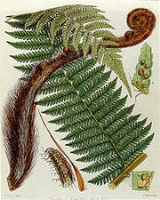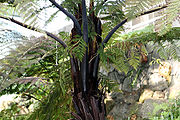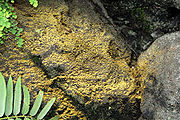
Cyathea smithii
Encyclopedia
Cyathea smithii, commonly known as the Soft Tree Fern or Katote, is a species of tree fern
.
, South Island
, Stewart Island/Rakiura
, and the Chatham Islands
of New Zealand
south to the Auckland Islands
. It is common in montane forest, with populations from the southern regions of its range growing in lowland forest. In the Westland
forests of South Island, C. smithii occurs in the understory of certain broadleaf/podocarp forests.


Cyathea smithii produces masses of very soft and delicate looking fronds which spread horizontally from the crown and reach 2–2.5 m in length.
Tree fern trunks have been used as rough building material, fencing, and makeshift trackwork.
Cyatheales
The order Cyatheales is a taxonomic division of the fern subclass, Cyatheatae, which includes the tree ferns. No clear morphological features characterize all of the Cyatheales, but DNA sequence data indicates that the order is monophyletic. Some species in the Cyatheales have tree-like growth...
.
Distribution and ecology
The species natural distribution covers North IslandNorth Island
The North Island is one of the two main islands of New Zealand, separated from the much less populous South Island by Cook Strait. The island is in area, making it the world's 14th-largest island...
, South Island
South Island
The South Island is the larger of the two major islands of New Zealand, the other being the more populous North Island. It is bordered to the north by Cook Strait, to the west by the Tasman Sea, to the south and east by the Pacific Ocean...
, Stewart Island/Rakiura
Stewart Island/Rakiura
Stewart Island/Rakiura is the third-largest island of New Zealand. It lies south of the South Island, across Foveaux Strait. Its permanent population is slightly over 400 people, most of whom live in the settlement of Oban.- History and naming :...
, and the Chatham Islands
Chatham Islands
The Chatham Islands are an archipelago and New Zealand territory in the Pacific Ocean consisting of about ten islands within a radius, the largest of which are Chatham Island and Pitt Island. Their name in the indigenous language, Moriori, means Misty Sun...
of New Zealand
New Zealand
New Zealand is an island country in the south-western Pacific Ocean comprising two main landmasses and numerous smaller islands. The country is situated some east of Australia across the Tasman Sea, and roughly south of the Pacific island nations of New Caledonia, Fiji, and Tonga...
south to the Auckland Islands
Auckland Islands
The Auckland Islands are an archipelago of the New Zealand Sub-Antarctic Islands and include Auckland Island, Adams Island, Enderby Island, Disappointment Island, Ewing Island, Rose Island, Dundas Island and Green Island, with a combined area of...
. It is common in montane forest, with populations from the southern regions of its range growing in lowland forest. In the Westland
Westland District
Westland District is a territorial authority on the west coast of New Zealand's South Island. Its population is - Government :The Westland District is governed by an elected Council, headed by an elected Mayor. The Mayor is elected at large. The current Mayor is Maureen Pugh. Councillors are...
forests of South Island, C. smithii occurs in the understory of certain broadleaf/podocarp forests.


Description
Katote is an understory tree fern that grows up to 8 m tall but tends not reaching into the canopy as do other iconic members of this genus. It grows slowly and is not a strong competitor except at higher altitudes. Like all Cyathea tree ferns, it has rough scales along its rachis and trunk. A distinctive feature is the retention of dead fronds as a skirt. The skirt is not the whole frond, only the central rachis, making it a more compact skirt than that of Dicksonia fibrosa, another skirt clad tree fern.Cyathea smithii produces masses of very soft and delicate looking fronds which spread horizontally from the crown and reach 2–2.5 m in length.
Cultivation
Cyathea smithii suffers in exposure to wind, sun and frost and is prone to drying out, but can be grown successfully in sheltered areas.Uses
The pith was traditionally used as a starch source, but as it is rich in resin, it would likely be a food of last resort or at least an acquired taste.Tree fern trunks have been used as rough building material, fencing, and makeshift trackwork.

